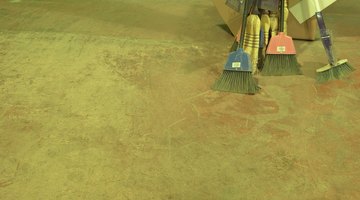Can I Tell If Concrete Sealant Was Applied?
Sealing concrete in and around your home can extend the life of the product. Most sealants soak into the cement, filling the air pockets within the porous material and strengthening the material while protecting it. Concrete sealant helps to prevent erosion caused by moisture from weather and by chemicals like the salt or mag-chloride used to keep roads de-iced in winter.

Testing
Concrete with a sealant often appears to have a slight sheen to it. The surface should look smooth, as opposed to the rough look of unsealed concrete. Freshly applied concrete sealant makes the concrete look like it is wet. In most cases, appearance can indicate a seal, but there are times when the appearance might mislead you. If you aren't sure whether or not your concrete has a seal, there are a couple of things you can do to determine the answer.
Beaded water indicates your concrete has a sealant applied to it. When it rains, check to see whether or not the water beads where it hits the concrete. You can also pour water onto the concrete in different areas to test this. If the water soaks in, the concrete does not have a sealant.
Most concrete sealers are clear in color; however, some products will turn yellow when exposed to sunlight or UV rays. If someone sealed your concrete with a yellowing sealant, you should be able to see the discoloration caused by the sun. If your concrete is in the shade, you can test an inconspicuous area with a UV ray.
Condition
You can also evaluate the condition of the concrete to help you find an answer. Sealing often prevents capillaries from forming in the concrete because the sealant bonds the porous material. The presence of these fine lines running throughout the cement can indicate the lack of a sealant.
More severe damage can also show a lack of sealant. Concrete scaling occurs when the surface of the concrete begins to flake off. This often is the result of unsealed concrete going through a winter in which the concrete froze and then thawed, degrading the surface.
Misconceptions
The absence of beaded water or the presence of conditions usually found in unsealed concrete is not a guarantee that someone did not seal your concrete. Using an inadequate sealant can lead to the onset of conditions mirroring those found in unsealed concrete. Also take into consideration the age of the home. Sealant can eventually wear off, and you could need to reapply a new coat of protection.
References
Photo Credits
- Hemera Technologies/AbleStock.com/Getty Images
- Hemera Technologies/AbleStock.com/Getty Images
More Articles



